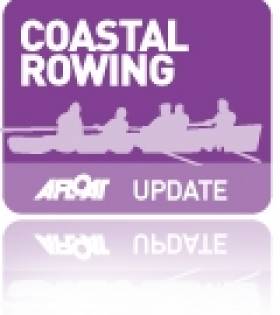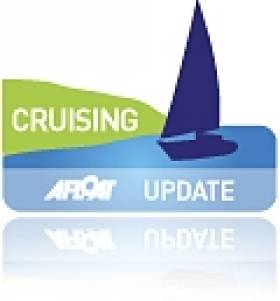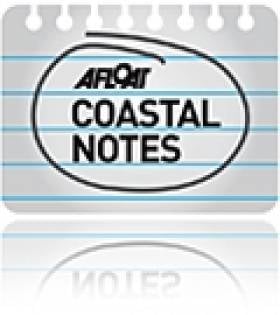Displaying items by tag: Baltimore
Body Of Missing Student Recovered Off Baltimore
#Baltimore - RTÉ News reports that the body of student Barry Davis Ryan was recovered off the coast of West Cork yesterday evening (Friday 10 July) after a week-plus search operation.
As previously reported on Afloat.ie, diving volunteers from all over Ireland had joined the recovery effort this week more than seven days after the tragedy that took the lives of Davis Ryan's girlfriend, Niamh O'Connor (20), and his father, 51-year-old Barry Ryan, when all three were washed out to sea from the shore near Baltimore on Tuesday 30 June.
Davis Ryan's remains were reportedly found in the last search window before poor weather would have halted efforts till next week.
#Missing - Diving volunteers from across Ireland joined the effort to search for missing student Barry Davis Ryan off West Cork yesterday (Thursday 9 July), more than a week after the tragic death of his father and girlfriend.
As previously reported on Afloat.ie, 51-year-old Penney's retail scion Barry Ryan and 20-year-old Niamh O'Connor were recovered off the coast near Baltimore on Tuesday evening 30 June, but died soon after.
Davis Ryan was last seen entering the water to rescue O'Connor, who had been swept into the sea while walking on rocks. His father then followed them into the water as they were both in difficulty, but all three were swept out to the Eastern Hole, as The Irish Times reports.
Despite poor weather conditions over the last week, the search has continued for Davis Ryan, with John Kearney of the West Cork Underwater Search and Rescue unit expecting as many as 200 dives by more than 100 volunteers to be conducted yesterday between 6am and 10pm, searching a rocky area some 23 metres deep, 300 metres long and almost a kilometre wide.
And 60 divers were expected to join the effort this morning (Friday 10 July) before forecast poor weather sweeps in later today. The Irish Times has more on the story HERE.
Two Dead, One Missing In Baltimore Drowning Tragedy
#Tragedy - A descendent of the Penney's retail empire has been hailed as a hero after attempting to save the lives of his son and his son's girlfriend in a tragedy off West Cork yesterday (Tuesday 30 June).
As the Irish Independent reports, 51-year-old Barry Ryan dived into the sea off a popular Baltimore beauty spot to try to rescue his son Barry Davis Ryan (21) and his son's girlfriend Niamh O'Connor (20).
Davis Ryan had himself entered the water to save his partner after she was apparently swept out to sea from the rocks near Baltimore village yesterday evening around 6pm.
With all three in difficulty, Ryan called for his daughter Charlotte (14) on shore to raise the alarm, and Baltimore RNLI was on scene within 10 minutes.
However, despite the best efforts of lifeboat crews from Baltimore and Union Hall and local search and rescue units, the bodies of Ryan and O'Connor were soon recovered and pronounced dead shortly after being airlifted to Cork University Hospital.
The search for Davis Ryan was expected to resume at first light this morning after poor conditions hindered efforts last night. The Irish Independent has more on the story HERE.
#baltimorewoodenboatfestival – The Ilen School Gandelow crew are celebrating back in Limerick after taking the big rowing prizes at the Baltimore Wooden Boat Festival last weekend.
Rowing races at the West Cork festival included on Sunday a Pilot Race Event under sail and oar; a race to land a pilot on an incoming sailing boat in the Harbour then race back to finish at the Pier.
The crew were: Br Anthony Keane, Gary Wilmott, Matt Dirr, Ger Ryan, Tony Daly, Robert Smalle, Liam O'Donoghue, Mike Grimes and James Madigan.
More on the wooden boat festival
#woodenboats – In the annals of Irish seafaring, whether professional or amateur, only a very few can match the achievement of Conor O'Brien (1880-1952). Between 1923 and 1925, this multi-talented sailor from Foynes on the Shannon Estuary circled the world south of the Great Capes in the 42ft ketch Saoirse which he'd designed himself with the help of Tom Moynihan of the Baltimore Fisheries School Boatyard.
It was there that this unique vessel was built in 1922-23 as Ireland in general – and West Cork in particular – recovered from a short but brutal Civil War. The very fact that Saoirse was built in Baltimore, followed by the successful completion of her great voyage, became part of the slow post-war healing process. So as the 2015 Traditional and Classic Boat Season gets under way this weekend with the Baltimore Wooden Boat Festival, W M Nixon voices the hope that Saoirse – which had been feared totally lost since 1979 – may be re-born.
They're hardy sailors in West Cork. That lotus-land of easygoing cruising may seem a gentle place in high summer, yet down there they've felt the recent summer-delaying cold spell as sharply as anywhere else. But despite the unfavourable conditions, as usual in this last full weekend of May we'll see the Baltimore Woodenboat & Seafood Festival swing into action. And although wooden boats need reasonably good springtime weather almost as an essential for the annual refit, there'll be a colourful turnout of character vessels large and small.
But the talk of the town will not be about a boat which is showing her style off the busy Baltimore waterfront today. Indeed, not only will this very special boat not be there, but it's a moot point as to whether she still exists. Put another way: Does enough of Saoirse still exists to allow a re-creation of this wonderful little ship to be properly classified as a re-build?
The voyage of the Saoirse in 1923-1925 only gains further lustre and wonder with the passage of time. It was an achievement of greatness, yet of beautiful simplicity. It was a uniquely pioneering venture made by an Irish skipper in an Irish designed-and-built vessel, and it was the first major voyage by an Irish ship of any size flying the Tricolour ensign of the new-born nation.
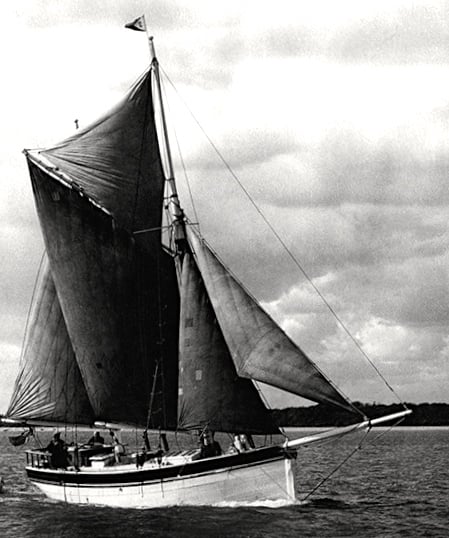
Saoirse under her original ketch rig in the 1950s, but with a boom fitted to the mainsail. Conor O'Brien had a loose-footed mainsail, and as evidenced here, the sail would have set much better but would have needed more attention in handling. (From a photo by Eric Hiscock)

In dry dock during the 1950s, Saoirse's "cod's head & mackerel tail" hull shape is clearly seen. Yet in the Great Southern Ocean on her voyage round the world south of the Great Capes, this bluff little 42ft ketch regularly logged 180 miles a day in comfort.
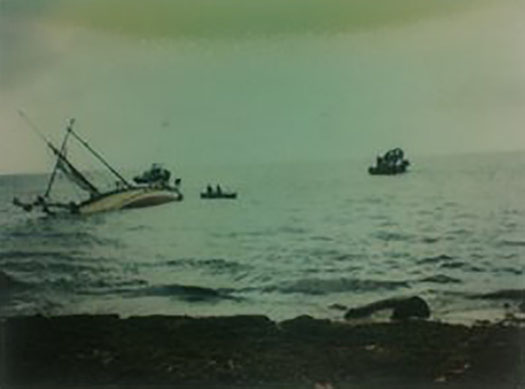
The wreck of the Saoirse in Jamaica, 1979.
Thus when the news in 1979 of Saoirse's destruction in a hurricane in Jamaica was confirmed, if anything it added to the legend. But it also meant that the only other boat created by the same team in the same place – the 56ft trading ketch Ilen (1926) – acquired added significance. But she was a long way away, still working the stormy seas around the Falkland Island, for which she'd been built after the islanders had been so impressed by the capabilities of the Saoirse, when she called there after rounding Cape Horn from the west, that they ordered a bigger sister-ship to become the inter-island workboat .
Yet thanks to a totally single-minded approach by Gary MacMahon of Limerick, Ilen was brought back to Ireland in 1998. And though it has taken quite a while for the various ideas to become reality, she is now well on the way to what has become a very public restoration with Liam Hegarty at Oldcourt Boatyard near Baltimore, while the Ilen Boatbuilding School in Limerick has become part of the fabric of Shannonside life, building not only the deckhouses and spars for Ilen herself, but an interesting selection of smaller boats ranging from traditional Shannon gandelows to the new CityOne sailing dinghies.
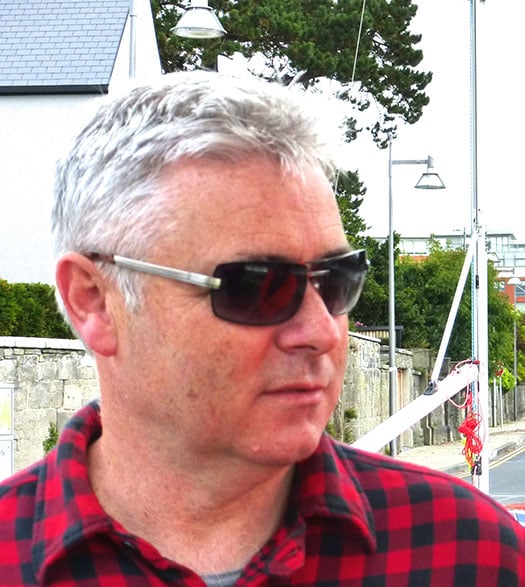
A man who just doesn't give up. Gary MacMahon of the Ilen School in Limerick. Photo: W M Nixon
By any standards, all these projects would be remarkable achievements in themselves. But in addition to his day job running one of Limerick's leading design studios, Gary MacMahon has for twenty years and more been quietly accumulating every bit of documentation of all sorts there is to be found relating to Saoirse.
It's an absolute treasure hoard of old photographs, certificates, plans, artefacts and other materials. And through this collecting, he has become well acquainted with Anthony Bolton who was Saoirse's last owner. Bolton had the misfortune of seeing his beloved boat destroyed by a hurricane in Jamaica before rescue attempts could save her after she'd dragged her anchor and gone ashore.
But though Saoirse was broken up by the battering of the hurricane, substantial pieces of her remained on the sea bed, and two sea-worn iron hanging knees – lovingly fitted by the Baltimore shipwrights 93 years ago – have recently been confirmed as definite relics of the wonderful little ship.
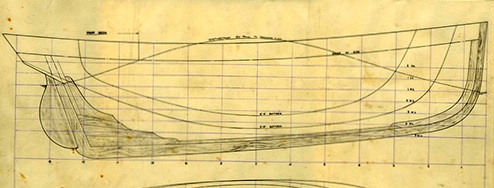
The hull lines of Saoirse as taken off by Uffa Fox in Cowes in 1927 before the start of that year's Fastnet Race (from which she retired, as endless windward work was not what she was designed for). Thanks to documentation of this quality, it will be possible to re-build Saoirse with precision. But in fact it has emerged that, such was the skill of Tom Moynihan and his boatbuilders in Baltimore in 1922-23, Saoirse as built very accurately followed the original lines drawn by O'Brien and Moynihan.

Saoirse's hull sections as recorded by Uffa Fox in 1927.
More importantly, though, the word is that much of the keel may still be intact. So just as he somehow got himself to the Falkland Islands to buy Ilen back in 1997, Gary MacMahon will shortly be going on the much easier journey to Jamaica for some real on-the-spot research as to just how much of Saoirse survives.
These days, it need only be a very small piece of the original to count as a re-build. But the spirit of the Ilen School is such that even if they find nothing at all in Jamaica, the notion of re-creating Saoirse is gaining so much traction, with that great shipwright Liam Hegarty among those totally taken with the idea of seeing Conor O'Brien's characterful little masterpiece sail again, that already the idea has acquired its own momentum.
But there'll be time enough when winter comes around again to give proper attention to the full range of Saoirse material which Gary MacMahon has amassed in order to ensure an authentic re-build. Meanwhile, this weekend may be seeing the new classic and traditional boat season kick into action in Baltimore, but already things are well under way in France, with last week's huge gathering in the Morbihan on the Biscay Coast, to which seven Dublin Bay Waterwags travelled, and eight returned.
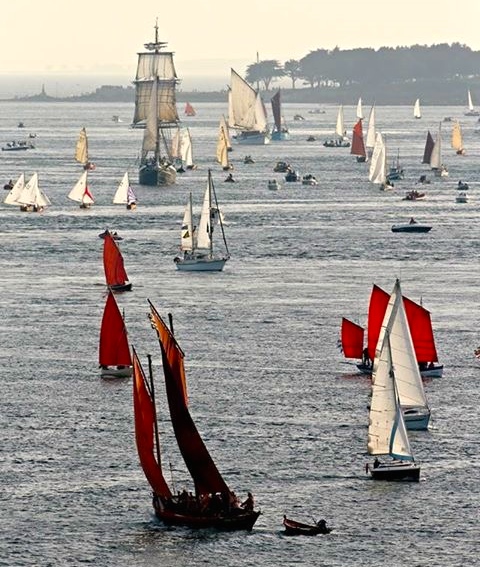
The wonders of the Morbihan. A very small part of the fleet at the Sailing Week eight days ago, with four of the Dublin Bay Water Wags at mid left. Photo: Courtesy Judith Malcolm
Like all the great French classic and tradboat festivals, the Morbihan event (it's full title is La Semaine de la Voile du Golfe de Morbihan, that's Morbihan Sailing Week in simple English) was mind-bending in terms of numbers, with 1200 boats of all shapes and sizes taking part. But the scale and layout of the Morbihan is such that it could well cope. The extensive inlet has six main ports, so the fleet was divided into six sub-groups of around 200 boats each. Everyone mingled out on the water during the day, then each night of the week-long festival saw your group going to a new port.
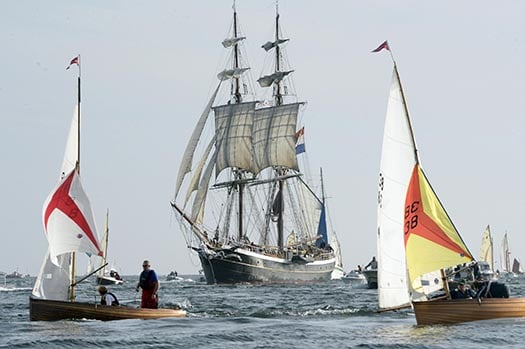
Two little Water Wags a long way from home – Ian & Judith Malcolm in the hundred year old Barbara (left) and Guy and Jackie Kilroy in Swift (right) in the midst of "sundry boats" in the Morbihan eight days ago. Photo courtesy Judith Malcolm
It worked, and it worked so well that the Irish flotilla of one Shannon One Design (Reggie Goodbody) and seven Water Wags not only had themselves a fine old time, but in a reversal of the usual story where our people return from distant places short of a boat or two, they came back with eight Wags, as Adam Winkelmann was united with his new boat. It was built in France as a boat-building academy exercise with a finish so exquisite that it was on exhibition in a marquee, but he was allowed to bring it home with him to Dublin Bay.
Far to the southwest in Baltimore, today we'll see a complex programme, as several traditional rowing craft (including a 23ft traditional Shannon cot or brochaun, the latest creation of Limerick's Ilen School built by a team headed by Tony Daly) were due to launch last night to berth at the pontoon in Skibbereen beside the West Cork Hotel. Today at 11am they start a rowing race all the way down the Ilen to Baltimore. Fortunately, the tide is ebbing.....
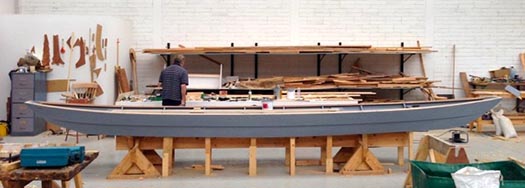
The new 23ft Shannon cot or brochaun is the latest creation of the Ilen School in Limerick. The cot's usual task was to head upriver from Limerick to fish, but today this boat will be rowed down the River Ilen from Sibbereen to the Baltimore Woodenboat Festival.
The rest of the day will see sailing and rowing races off Baltimore with a prize-giving dinner tonight in Baltimore Sailing Club presided over by Tom MacSweeney of this parish, then tomorrow (Sunday), as the one day Seafood Festival gets into full swing, there's perhaps the most interesting event of all afloat. This is the Pilot Race, in which the sailing boats put out to sea, and then turn and approach the harbour to be met by racing gigs each of which has to put a pilot on board one of the sailing craft which then race back into the harbour – it all makes for mighty sport.

Bowsprits at the ready, and the island ferry coming into port – it can only be Baltimore at Woodenboat Festival time
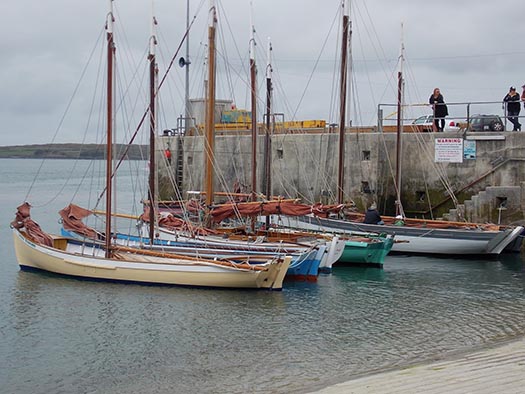
If you can identify even half of the boat types here, then you should be in Baltimore this weekend.
If your heart is with classic and traditional sailing boats, you can get an abundance of them by being in Baltimore this weekend, and then by being along Dublin's Liffey for the Riverfest in a week's time for the Bank Holiday weekend. It's a three day event (May 30th to June 1st) based on Poolbeg Y & BC, with the Old Gaffer's Leinster Trophy Race in Dublin Bay on Saturday, and then two days above the bridge for all sorts of city festivities and boat parades through to Monday evening.

The 117-year-old Howth 17s will be returning to the Dublin Riverfest in a week's time. Photo: W M Nixon
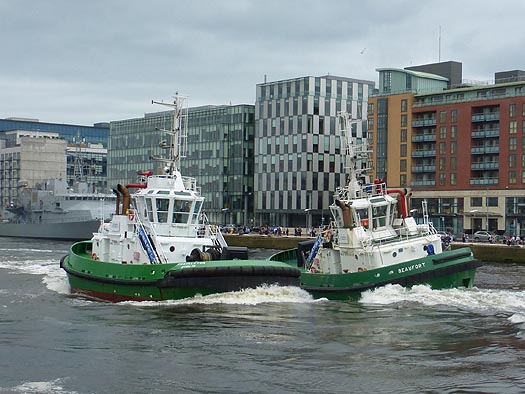
The famous waterborne ballet of the Dublin Port tugs Shackleton and Beaufort will be a main event in the Dublin Riverfest over the Bank Holiday Weekend of May 31st-June1st. Photo: W M Nixon
Following that, on Saturday 6th June out in Howth, the Classic Lambay Race is being provided within the annual Round Lambay Regatta (it dates back to 1904), with the Old Gaffers and Traditional boats joining the 117-year-old Howth Seventeens for a direct circuit from a pier start out to Lambay, round it and back again direct, with no fancy special mark rounding in between.
Defending champion in the Classic Lambay is OGA International President Sean Walsh of Dun Laoghaire with his cutter Tir na nOg, and extra interest is added this year as the fleet will include Dickie Gomes' 1912-vintage 36ft yawl Ainmara, built in Ringsend but now a longtime resident of Strangford Lough. There's a certain edge to Ainmara's involvement, as she was overall winner of the cruiser division in the 1921 Lambay Race when still owned and sailed by her designer-builder John B Kearney. But if you think this remarkable historic link will cause her opponents to give her an easy time of it, you're much mistaken.
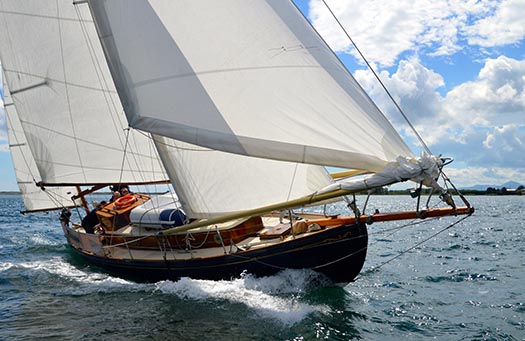
The 103-year old Ainmara – seen here on her home waters of Strangford Lough with the Mourne Mountains in the distance – will be returning to the Lambay Classic at Howth on June 6th 2015, which she last won in 1921. Photo: Pete Adams
Sean Walsh is having a busy year of it, as his duties as OGA President take him hither and yon, while Tir na nOg will be flagship for the OGA Cruise-in-Company which will follow the big one of 2015, the Glandore Classics Regatta from July 18th to 24th.
But for this weekend, he's in his home waters of Dublin Bay on a venture which means a lot to him, the OGA Youth Sailing Project at Poolbeg under the direction of Liam Begley. It's for youngsters who might not otherwise get a chance to sail. They're taken out to learn the ropes aboard two fine gaff cutters, the Clondalkin Community group's majestic Galway Bay hooker Naomh Cronan, and the OGA President's own Tir na nOg.
When we remember that many folk head from Dublin towards Cork to go sailing, it's intriguing that in this case the young people have come the other way, as they're a group from Mayfield Community School which has eternal fame through being the old school of Roy Keane.
The tyro sailors from Mayfield – there's nine of them, all in the 15-16 age group - have already become boat-acquainted through the Meitheal Mara Community Boatyard in Cork city. But the outing to Dublin puts a different spin on it all, as the first stage is devoted literally to teaching them the ropes, then after the sailing programme is completed out in the bay, the shift in skills is demonstrated by command of the two gaff cutters being given over to the Mayfield crews, who then have to sail them back to port.

OGA President Sean Walsh (top right) with Junior Gaffers from Mayfield Community School in Cork aboard Tir na nOg in Poolbeg in Dublin. Photo: John Galloway
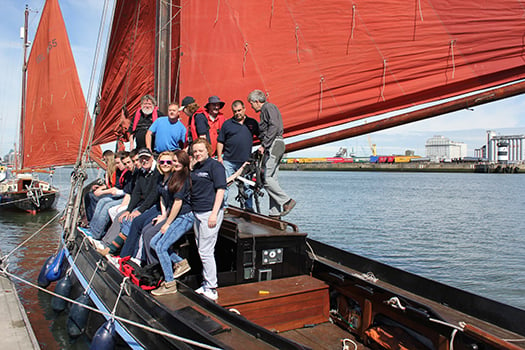
Junior Gaffers from Cork and Senior Gaffers from Dublin aboard the Naomh Cronan Photo: John Galloway
In all, it's an entertaining balance between an outing to Dublin, a chance to learn in a fun environment, and a real opportunity to demonstrate that practical skills have been well and truly acquired. And before somebody is driven to send in a rude comment after seeing these two photos of last year's Youth Sailing Project course, I hasten to assure you that when they do go sailing, everyone wears a lifejacket.
#blatimoreharbour – The new Baltimore harbour pontoon that was first installed in February and later removed is now back in situ for the coming season. Tweeters have sent us the latest photos from the West Cork harbour above. Afloat.ie first published news of the landing pontoon and Gangway to aid boating visitors last February.The facility is popular with aquatic tourists and local sailing club members alike.
More on the sailing and boating wonders of West Cork here.
#luggerroundireland – Two brothers will begin a circumnavigation of Ireland in an 18ft–Drascombe Lugger dinghy, Lughnasa this June bank holiday. Fergus and Nathaniel Ogden will set off on the c. 1000 mile voyage from Baltimore, West Cork. Hoping to achieve between 15-30 miles a day, they will live on-board the boat, calling into various stopovers along the coast - beginning with Crookhaven.
At an average speed of 3-4 knots, this won't be the fastest circumnavigation of Ireland ever achieved, but the Drascombe's rugged build quality makes it a fine boat for the job, and will be the first time an open Lugger has attempted to sail around Ireland.
They anticipate the voyage to take about a month, though the Atlantic conditions off the West Coast will play an important role in their journey time.
Aged 16 and 22, this will be the brother's longest voyage together. Personal space will take on a new meaning for the lads with cramped living on-board, and tensions are sure to run high as the 18 feet of Drascombe becomes home. Balmy days spent rolling on the long and gentle swells in the baking Irish sun will help reduce some of this pressure, however and provide plenty of opportunities for photo and video footage of the voyage. With none of the luxuries found inside a cabin, Facebook and website updates will be done as often as possible from their overnight stops.
The Ogdens are undertaking this challenge to raise funds for the RNLI, who are officially supporting their adventure.
By doing this they would like to help raise awareness for safety at sea as the number of lifeboat callouts for leisure craft has been increasing in recent years.
To keep up with the Ogden brother's progress visit their website where you can make a donation to the RNLI and follow their blog.

onboard the Lughnasa
ROUGH ROUTE PLAN, NOT CONSIDERING ALL CONTINGENCIES. LEAVING BALTIMORE AND HEADING WEST
Crookhaven
Castletown Bearhaven
Ballycrovane Harbour
Derrynane Harbour
Knightstown, Valentia
Dingle
Brandon
Kilrush/Carrigholt
Inishmore
+ /- Galway, Roundstone, Clifden, Cleggan
Inishbofin
Clare Island
Belmullet
Kilcummin
Rosebeg
Tory
+/- Lough Swilly Stopover
Portballintrae
Rathlin / Ballycastle
Donaghdee
Carlingford
Ardglass
Howth/Dun Laoghaire
Wicklow
Wexford
Kilmore Quay
Dungarvan
+/- Youghal
Cork Harbour - Crosshaven
Kinsale
Clonakilty
Glandore / Castletownshend
Baltimore
Marine Minister Forecasts Wooden Boat Building Revival
#woodenboat – Marine Minister Simon Coveney is confident that wooden boat building in Ireland is going to be revived writes Tom MacSweeney.
Traditional skills have been lost and there are fears that they will disappear forever, but the Minister sounds a confident note about preserving them on the current edition of my maritime programme, THIS ISLAND NATION.
"This project is going to reinvigorate wooden boat building in Ireland again. It is going to open a new chapter for us," he says. "Hopefully multiple ports around the country will be able to build projects like this in the future. We still have great skill sets of wooden boat building available to us in Ireland which we must not lose. It is projects like this that will keep them alive and encourage a new young generation."
I recorded Mr.Coveney at Liam Hegarty's boatyard at Oldcourt near Skibbereen where the Ilen, the last traditional sailing boat of its kind, is being restored. It is the boat which the legendary Conor O'Brien had built for the Falkland Islanders who so admired his previous vessel, Saoirse, when he sailed it into those islands during his round-the-world voyage in 1923-25. Liam Hegarty's yard at Oldcourt on a bend of the road from Skibbereen to Baltimore in West Cork is one of the few remaining that specialises in wooden boat building.
The Falklanders asked O'Brien, the first Irishman to sail a round-the-world voyage to emulate the boat on which he arrived in Port Stanley. He did as they asked, having the Ilen built in Baltimore, where Saoirse was also constructed. With two Cape Clear Islanders as crew, he sailed it to the Falklands in 1926 where it worked for 70 years until Limerickman, Gary McMahon, had it brought back to Ireland in 1997:
I was the only reporter on the quayside in Dublin when it was landed there from the deck of a cargo ship, looking every bit her age of 71 years at the time. So it was a great feeling to stand on her deck in Liam Hegarty's boatshed where the restoration work has been carried out, in conjunction with the AK Ilen boat building school, initiated by Gary McMahon, the driving force of the project Such a change from the condition in which I had seen her in the Dublin docks 18 years ago.
Gary McMahon, Liam Hegarty and Minister Coveney tell the story on the programme. Gary and Liam are both confident that Ilen will be back in the water, sailing once again. She may provide opportunities for effective sail training. Several sources have provided restoration funding. More is needed for a project which, as the Minister said, can restore Ireland's resource of traditional skills.
Also on the programme you can hear the story of a submarine which sank not once, but twice, which will make you wonder whether superstition about changing the names of boats is correct. And did you know that the Dubs beat the Kingdom ... Not in football, but fishing...?
You can hear more by listening to THIS ISLAND NATION above.
Baltimore Harbour Landing Pontoon & Gangway to Aid Boating Visitors & Aquatic tourism
#baltimore – First pictures from Baltimore Sea Safari marine company show the West Cork village's smart new central pontoon and gangway being put in place in the inner harbour. The new Baltimore harbour facility will be beneficial as a landing place for visiting boats.
And it's sure to be useful to the Optimist dinghy class when 160 gather at Baltimore Sailing Club for the mid–term school break next week.
More on the sailing and boating wonders of West Cork in WM Nixon's blog here.
Baltimore Optimist Training Week Attracts 160 For Spring Break
#optimisttraining – IODAI, the International Optimist Dinghy Association of Ireland has over 160 signed up for its Spring training week (15th February – Friday 20th February) which is open to all IODAI members and will be held in Baltimore Sailing Club writes the IODAI's Aidan Staunton.
As Afloat reported previously last October the village of Baltimore will be taken over by approximately 160 sailors and their families for the week of February mid-term. Coaches have all been booked and typically they are a mix of the top Irish and international coaches; from Greece, Portugal, Sweden and Poland,
Training will be provided daily for sailors from Regatta fleet level (must be able to sail a triangle)- to those who are competing internationally. We particularly would like to encourage sailors who have not attended an event outside their own club in the past, to consider coming to Baltimore, which is a non-competitive, fun week intended to build enthusiasm for sailing and to allow sailors from around the country to get to know each other. The Baltimore event is considered to be one of the top International clinics in Europe and ends with a one day regatta on the last day.
It is very much a family-oriented event, with a programme of activities for children too young to sail (Fitbones), and events also organised for adults, such as the 'How to Rig an Oppi' class for novice parents!
The event is organised by IODAI which is comprised of volunteers, mainly parents of sailors, who organise the Optimist events calendar. Because everyone is a volunteer, Baltimore is an 'all hands on deck' week, with parents encouraged to lend a hand with the work that goes into making it such a special event. Helping out with sailors lunches, doing slip duty, rescue on the water, and helping at the social activities, means that all parents will get to know each other just as well as the sailors do.
An IODAI forum takes place during the Baltimore week where all parents are invited to express their views or seek information on the running of the Optimist class.






























